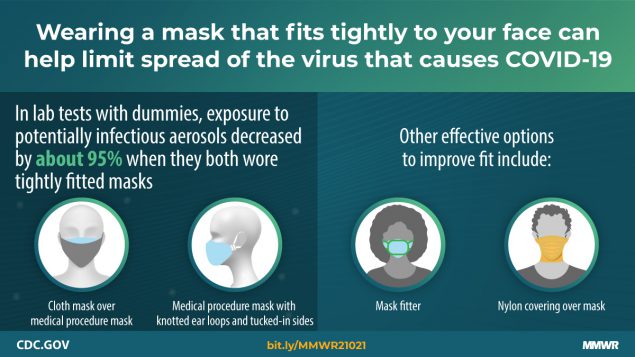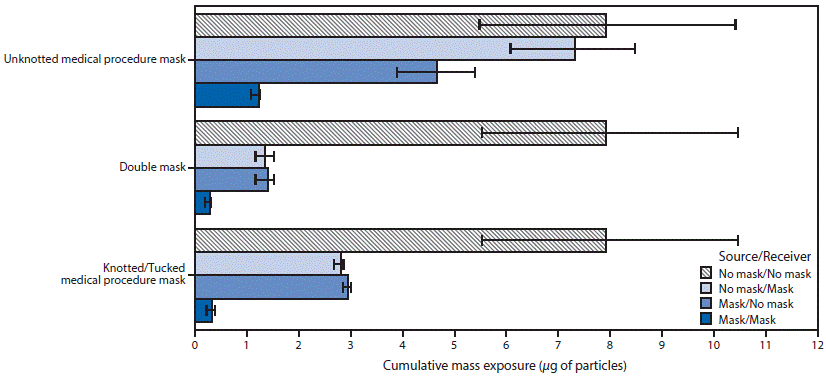Fitting a cloth mask over a medical procedure mask, and knotting the ear loops of a medical procedure mask and then tucking in and flattening the extra material close to the face substantially improved source control and reduced wearer exposure to the 2019 Novel Coronavirus and other potentially infectious aerosols by as much as 95 percent, according to experiments which were conducted by the Centers for Disease Control and Prevention of the United States.
Tightly Fitted Masks Reduced Exposure By Approximately 95 Percent, According to the Centers for Disease Control and Prevention
The Wednesday, February 10, 2021 edition of the Morbidity and Mortality Weekly Report of the Centers for Disease Control and Prevention concluded that the aforementioned two modifications of improving the fit of medical procedure masks highlight the importance of good fit to maximize the performance of masks and coverings for the nose and mouth, as multiple simple ways to achieve better fit of masks to more effectively slow the spread of the 2019 Novel Coronavirus.

“Results from the first experiment demonstrated that the unknotted medical procedure mask alone blocked 42.0% of the particles from a simulated cough (standard deviation [SD] = 6.70), and the cloth mask alone blocked 44.3% (SD = 14.0). The combination of the cloth mask covering the medical procedure mask (double mask) blocked 92.5% of the cough particles (SD = 1.9)”, according to the aforementioned report. “In the second experiment, adding a cloth mask over the source headform’s medical procedure mask or knotting and tucking the medical procedure mask reduced the cumulative exposure of the unmasked receiver by 82.2% (SD = 0.16) and 62.9% (SD = 0.08), respectively (Figure 2). When the source was unmasked and the receiver was fitted with the double mask or the knotted and tucked medical procedure mask, the receiver’s cumulative exposure was reduced by 83.0% (SD = 0.15) and 64.5% (SD = 0.03), respectively. When the source and receiver were both fitted with double masks or knotted and tucked masks, the cumulative exposure of the receiver was reduced 96.4% (SD = 0.02) and 95.9% (SD = 0.02), respectively.”

Ironically, both the Centers for Disease Control and Prevention and the World Health Organization initially advised against wearing face masks in response to the 2019 Novel Coronavirus pandemic, as they were deemed not necessary in order to stay healthy — supposedly as a measure to not incite panic while simultaneously preventing a run on masks used by people who work in the medical profession and thus creating a shortage of those masks…
…but then on Friday, April 3, 2020, the Centers for Disease Control and Prevention issued an advisory with the recommendation of covering your face with a simple cloth covering the nose and mouth — such as a scarf as one of many examples — in order to slow the spread of the 2019 Novel Coronavirus in the United States; and that conflicted at the time with the recommendations from the World Health Organization.
A Look at the Latest Statistics

The latest statistics are that at least 2,347,015 people — or slightly greater than 2.19 percent — have died of the minimum of 106,991,090 confirmed cases worldwide, according to this situation dashboard from the World Health Organization pertaining to the 2019 Novel Coronavirus…
…and at the same time, at least 2,359,200 people — or slightly greater than 2.19 percent — have died of the minimum of 107,529,461 confirmed cases worldwide, according to this situation dashboard from Johns Hopkins University & Medicine pertaining to the 2019 Novel Coronavirus.
At the time this article was written, at least 466,465 people — or slightly less than 1.73 percent — have died of the minimum of 27,030,549 confirmed cases in the United States, according to this situation dashboard from the Centers for Disease Control and Prevention pertaining to the 2019 Novel Coronavirus — and with an estimated population of 331,002,651 people, that means that slightly greater than 0.14 percent of the population of the United States have died with it.
The population of the world is currently at almost 7.8 billion people. Using the higher statistics from Johns Hopkins University & Medicine, that means that slightly fewer than 1.38 percent of the population have confirmed cases of 2019 Novel Coronavirus, with slightly greater than 0.03 percent of the population having died with it.
Summary

If the findings are indeed true and the results of the experiments are accurate, could this mean that we may be required to wear masks for the rest of our lives? After all, the experiments suggest that we could also reduce our exposure to potentially infectious aerosols — such as viruses which cause influenza and the common cold as two of numerous examples — and especially those which could possibly result in death.
The mixed messages during the past year from noted authorities, reliable sources, scientists, and experts in the medical profession may be one of a plethora of reasons why people still refuse to wear masks at all. I do not understand why these experiments were not performed years ago on potentially infectious aerosols in preparation for an epidemic or pandemic — which scientists had been forecasting would eventually occur — so that a consistent and apolitical message can be broadcast from the beginning of any epidemic or pandemic.
I still believe that the single most effective way of preventing the spread of the 2019 Novel Coronavirus is to thoroughly wash hands — and to not touch any part of the face and ears until after the hands are thoroughly washed…
…and yet, I still see people who use the toilets and not washing their hands at all during the time they are using the washroom — whether or not they are wearing masks or coverings for their noses and mouths.
Additionally, people still tend to discard of their masks by literally littering them onto the landscape instead of properly disposing of them.
I personally do not want to constantly wear a mask or other covering over my face for the rest of my life.
Other articles at The Gate which deal with the topic of masks include:
- Masks Must Be Worn While Traveling: Mandatory Order by The Centers for Disease Control and Prevention
- Disgusting How Masks Seem to Be Everywhere
- 14 Reasons Why Anyone Would Want to Wear a Mask
- 14 Reasons Why Anyone Would Refuse to Wear a Mask
- The Debate Over Wearing Masks
- Face Covering? No Face Mask? Why Seemingly Conflicting Information From Two Reliable Sources
- Should Passengers Be Required to Wear Masks Aboard Airplanes?
- Earth Day 2020: More Littering of Contaminated Gloves and Masks From the 2019 Novel Coronavirus
- Stop the Spread of Littering Contaminated Gloves and Masks, Please
- Update August 4 2020: Face Masks Required at These Rental Car Facilities in the United States
- Face Masks Required at These Rental Car Facilities in the United States Effective as of July 27, 2020
- Face Mask Policies Further Restricted by Marriott and Delta Air Lines
- Face Mask Requirements to Become Standard at Lodging Properties in the United States
- Stricter Requirements for Wearing Masks By Delta Air Lines
- Georgia Governor Sues Atlanta Mayor to Block Mask Requirement
- Is Wearing Masks Required or Not in Atlanta and Its Airport?
- Update: Passengers Must Wear Face Coverings or Masks With These Airlines Based in the United States
- Passengers Must Wear Face Coverings or Masks With These Airlines Based in the United States
- Are Masks Effective Against 2019 Novel Coronavirus That People are Stealing Them?
All photographs ©2020 by Brian Cohen.

